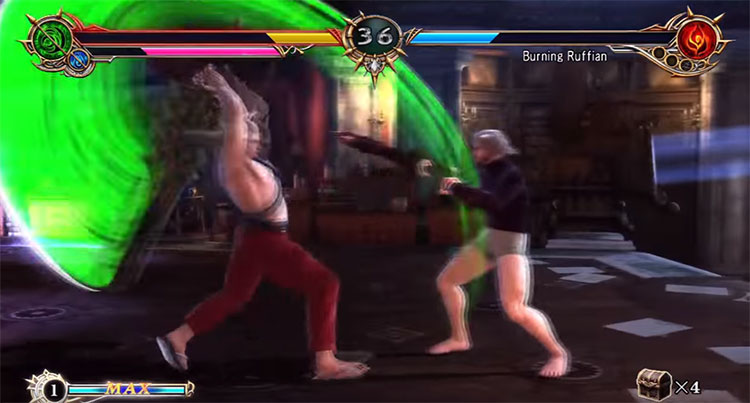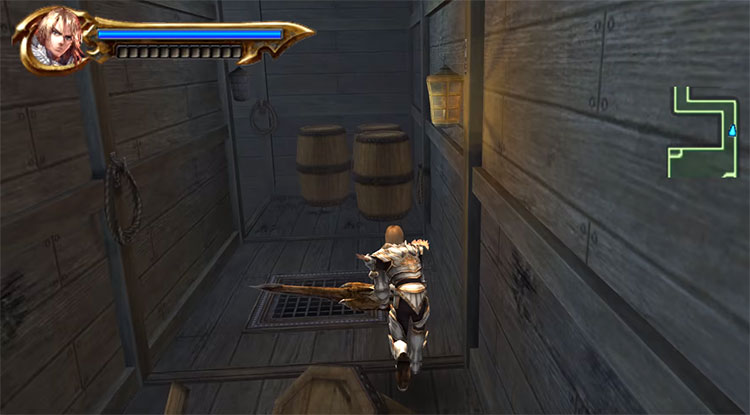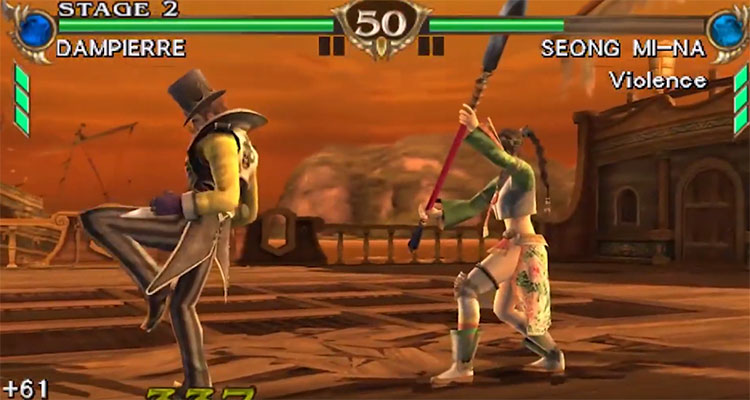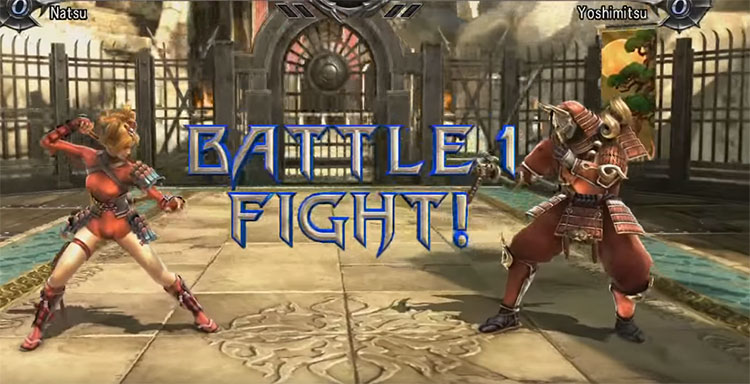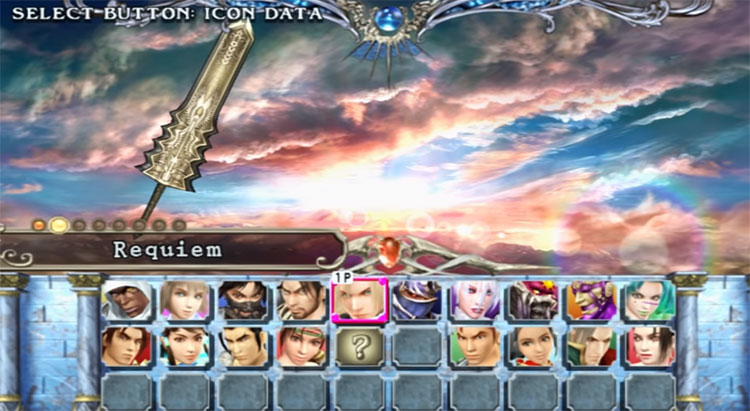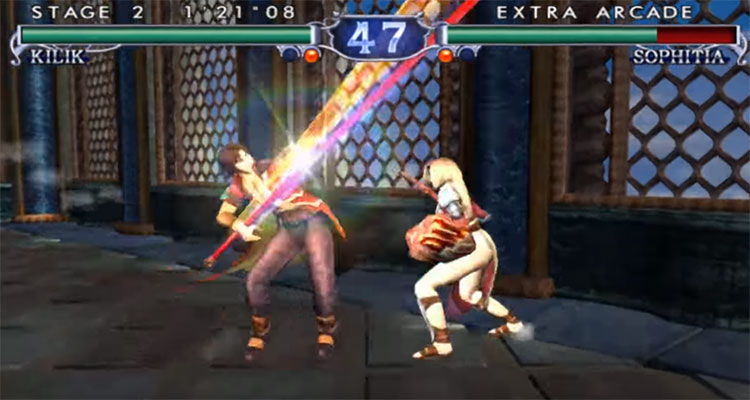Developer Project Soul has always brought something new into the mix, along with notorious graphical achievements. A heavy emphasis on character customization and flashy battles has also kept fans hooked in the last couple of releases. Not only that, but their smart use of Bandai Namco’s influence in the industry, along with the big name Soulcalibur has made for itself, has allowed them to include guest characters from top-grossing franchises like Star Wars and The Witcher. Join me as I take a look at every game in the Soul Series. I’ll be comparing their strengths, weaknesses, and contribution to the development of the franchise as a whole.
10. Soulcalibur: Lost Swords (2014)
Mostly based on Soulcalibur V’s gameplay, this free-to-play title offered players the opportunity to embark on a journey that would take them all around the world collecting materials to craft equipment for their characters – with the caveat that they’d be restricted to a certain amount of playtime per day. Unless, of course, they purchase items and extra playtime through micro-transactions. While I know that getting a game for free isn’t something to complain about. The simplified combat mechanics and strictly single-player gameplay really take away from the experience. Considering it was discontinued after a year, one is left wondering what the point of Lost Swords was.
9. Soulcalibur Legends (2007)
Somewhat better albeit still not up to the standards set by the rest of the franchise is Soulcalibur Legends, a Wii exclusive meant to serve as the console’s alternative to Soulcalibur IV. Unlike the rest of the series, this experimental title is a hack’n’slash adventure focusing on Ivy and Siegfried in the time between the original Soul Edge and its sequel, Soulcalibur. Even though a competitive mode is available, the game shines more for its Co-Op capabilities. And most importantly, I think it shines for the appearance of Lloyd Irving from Tales of Symphonia, which overjoyed my inner fan boy to no end.
8. Soulcalibur: Broken Destiny (2009)
Defying what you’d usually expect from a downscaled portable version of the main game, Soulcalibur: Broken Destiny serves as an excellent re-imagining of Soulcalibur IV for the PSP. The main feature unique to this Soulcalibur release, other than the fact that it replaces the Star Wars characters from IV for the God of War himself, is The Gauntlet. This mode allows players to train themselves, completing challenges aimed at honing your Soulcalibur skills with some interesting narrative sprinkled on top.
7. Soulcalibur V (2012)
While Soulcalibur V is in no way a bad game, it definitely didn’t live up to the fandom’s expectations. Or rather, it did many things that angered stalwart Soulcalibur enthusiasts. Released for the PS3 and XBOX360, Soulcalibur V’s narrative centers around Patroklos and Pyrrha, the children of Sophitia, and their quest to free Pyrrha from Soul Edge’s curse. In keeping with this “changing of the guard” motif, the game also replaces classics like Taki and Kilik for new, younger characters with similar fighting styles. It’s in the gameplay that Soulcalibur V proves its worth, making several changes to combat mechanics to make the game even faster and more aggressive than Soulcalibur IV. Also, Ezio Auditore da Firenze is the guest character. Hype!
6. Soul Edge (1995)
Before there was Soulcalibur, there was Soul Edge, the birthplace of the cursed sword of the same name. This amazing arcade fighter was a shiny gem among the many button-mashers populating game centers all around the world. Not only were the graphics out of this world, but its gameplay was also innovative. It focused on the use of weapons rather than bare fists, and characters could side-step between the background, middle ground and foreground during a fight. Furthermore your weapon could actually break if you blocked too much, promoting a more aggressive playstyle. Once the expanded version came out on the PS1 in 1997 it quickly became a well-known name.
5. Soulcalibur (1998)
But it was the sequel that really defined what the Soul Series was about when it came out for arcades in 1998, becoming the second best-selling Dreamcast game after being released as a launch title in 1999. Other than featuring several new characters that would become fan-favorites, such as Kilik and Lizardman, Soulcalibur introduced the famous 8-way run system. This allowed fighters to move freely all over the fighting ring. Its innovative yet polished mechanics, along with its stunning graphics and interesting narrative, earned it several awards and the love of fans worldwide.
4. Soulcalibur III (2005)
One of the most ambitious and experimental entries in the entirety of the Soul Series is its fourth installment, Soulcalibur III. This PS2 gem brought the Create-A-Soul character creation into the series, which was very exciting at the time. It came coupled with Chronicles of the Sword, a sort of RPG/RTS hybrid campaign that put players in control of Create-A-Soul characters along with guests from the main story, which they commanded to capture forts and complete objectives in diverse battlefields. Soulcalibur III is also the entry with the largest character count and battle stages in the entire series, and introduced now-beloved characters like Tira and Sazalamel.
3. Soulcalibur II (2002)
Considered the best game in the series by the kind of fans that play fighters as a sport, Soulcalibur II might be the release with the most balanced combat in the franchise. Not only that, but it introduces Guard Break moves and makes input timing important in several ways, adding more depth to the game’s combat. A better sidestep mechanic also helps give players more defensive options other than blocking. It also has some of the most varied guest characters, since each console got a different one. Tekken’s Heihachi Mishima for the PS2, Link for the GameCube and… Spawn, for the Xbox? Well, that was unexpected but still very cool.
2. Soulcalibur IV (2008)
The game I’ve played the most out of every Soulcalibur is also the second-best in the franchise. In great part due to its aesthetic achievements and amazing soundtrack. Soulcalibur IV was celebrated for having an incredibly detailed character creator, and looking at your custom characters in glorious HD thanks to seventh-generation hardware was a gift for the soul. Soulcalibur IV also makes some much-needed changes to the core gameplay. The Soul Break mechanic, for example, allows players to destroy their opponent’s armor and clothes, leaving them briefly open to finishing moves. This was revolutionary to many players. Plus it’s the first game in the series with full online multiplayer so that’s neat.
1. Soulcalibur VI (2018)
It was a tough call between IV and VI, but in the end, the most recent release for eighth-generation consoles also turns out to be the best one in this writer’s eyes. Not only does it include two of the most hype-inducing swords-people ever, namely Geralt of Rivia and 2B from NieR Automata, but it serves as a much-needed reboot for the franchise. What really made me give it the top spot is the addition of the Reversal Edge parry mechanic, a counter-attack move that gives players more defensive options without making the game any slower. As it stands, it’s the most refined Soulcalibur combat that I’ve seen. And it’s beautiful.
